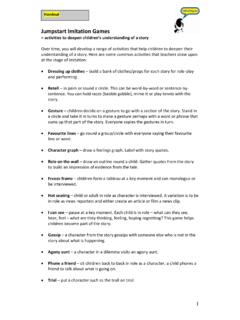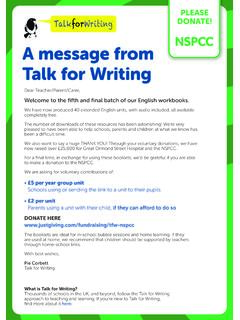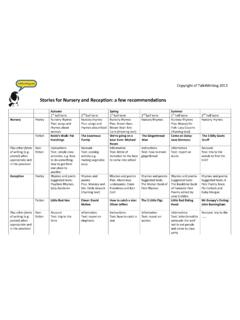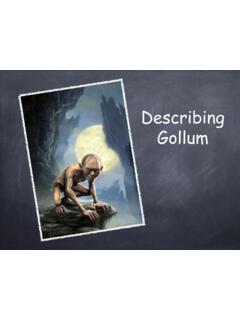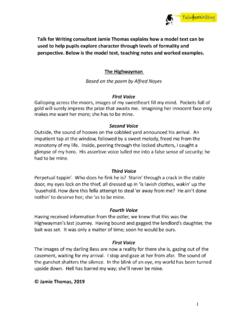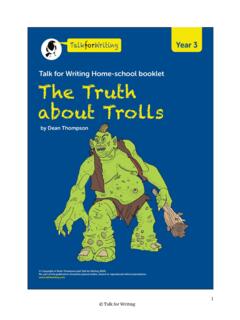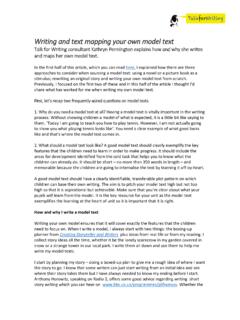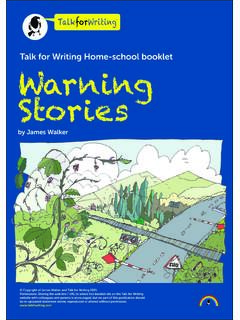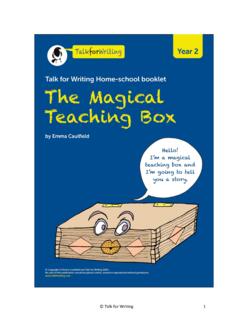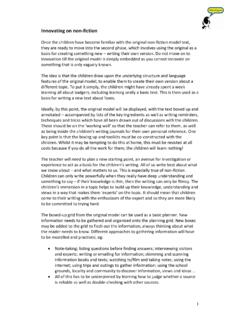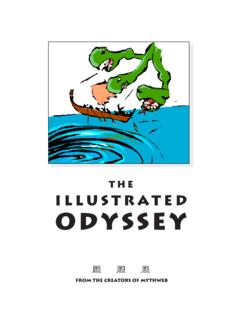Transcription of Meerkat Mail - Talk for Writing
1 Meerkat mail Meerkat mail is a great KS1 cross curricular unit of work underpinned by the Talk-for- Writing approach by Talk4 Writing consultant Carol Satterthwaite. In the words of a certain TV advert Meerkat , a book project using Meerkat mail by Emily Gravett is simples! , especially if you use the Talk-for- Writing process. As a core story for a half term, it is perfect for KS1 with plenty of text types to focus on, captivating illustrations, quirky characters and lots of humour. It s also a fabulous way to develop geography, PSHE, art and history through a theme such as Amazing Animals. There s no place like This is a story of self-exploration, of believing that the grass is greener, of leaving home and coming back Our hero Sunny the Meerkat lives with his extended family in the Kalahari Desert and is fed up with two things the place where he lives and the people (or meerkats!)
2 He lives with. It s time to move on, so he packs his suitcase, writes a note and starts his search for a better place to eat his ice-creams. We join him on his search, along with a hungry jackal who is always close behind him, as he travels from one global family member to another. Needless to say, each place seems to have its own set of problems and Sunny finally arrives at the eternal message there is no place like home . There are endless possibilities for using this text but, if you are the kind of person who likes a bit of a sequence, read Starting the Using the book as part of a project on Amazing Animals, precede the actual reading of it with a week of experiences and research focusing on animals, including some or all of the following: Launch with a visit from a wild animal sanctuary [meerkats included if possible of course!]
3 ]. Discuss and record what the children know about these particular animals and support them in preparing their questions for the visit. Immerse the children in visual images and film clips if there is no animal sanctuary near to you and then role play a wild animal expert for the children to hot-seat . Focus on reading a range of printed and multi-modal information texts, then provide umpteen opportunities for them to gather facts about wild animals across the world but not meerkats, as you will need this animal later! Model how to record information using a spidergram in notes and drawings. Provide other methods of recording their research , a Flip camera or audio recorder. Watch DVD clips of the chosen animals, read texts, play games such as True or False , create information sorting, sharing and matching activities.
4 Model a short oral presentation using images David Attenborough style, Polar bears live in one of the coldest parts of our planet the North Pole. They have extremely thick fur to protect them from the cold. They usually eat seals but also catch fish. This is an excellent way of introducing new vocabulary and learning language structures. The children can then work in pairs or small groups to prepare an oral mini-presentation using their own animal facts. An excellent Writing outcome for this week could be a Top Trump card for the animal of choice. Suggested routes Introduce Sunny Either through an image or a Meerkat stuffed toy it will be a good investment! Read the whole text using a text visualiser to amplify the images on your IWB.
5 The illustrations convey as much as the text and children can be helped to understand events, feelings, character details and motivations by close reading of both. Wish you were Re-read and talk about the postcards Sunny sends from each location layout, language, text conventions brackets, and discuss the information they give about where he is and what his current relative is like. Collect information under headings such as: where he is / what he eats / what the weather is like / what he does / what he likes and dislikes. Take photos of Sunny at the local park, eating something , in different weather etc. Share these images with the children, explaining that they are Sunny s latest adventure.
6 Model write a postcard from Sunny to his family, using the information headings to structure the content. The children can then conduct a guided tour of the school with Sunny, taking photos of him in different places, answering any questions he may have and helping him join in activities. The children can then write their own postcard from Sunny about his trip to their school. Did you Read examples of non-chronological reports about animals and start to develop a bank of common features. Use role play and games such as Professor Know it All * to develop the language and sentence constructions of reports. Create a non-fiction report Use Pie Corbett s Talk for Writing sequence (Imitation-Innovation-Invention), with a final outcome of a mini-leaflet or Wikipedia page.
7 Start with teaching an oral report on meerkats to the class, using a text map to support the process. An example text could start: Meerkats are a type of mongoose. They live in the desert in Africa. Usually they live in family groups. This protects them from predators. Once the children have learnt the text, then Innovate with another animal, using facts gathered in the first week. Create a whole class one together orally and practise it, then allow the children to make up their own oral versions about the animal they researched in week one. Model write a report based on the whole class Innovation animal and then support the children in Writing their own. Collate and publish in a laminated booklet, folder or on the school s website.
8 Read aloud to other classes, parents or as part of a presentation during assembly. Tell me a This is a great example of a journey story, with Sunny travelling the world and then returning back home hopefully a more contented Meerkat ! Write an oral version of the story in the past tense, including more story connectives, After that, Eventually etc and learn it. Innovation An Innovated version could be Sunny trying to find a home at the seaside, in the supermarket, at an indoors play area wherever you think the children have enough collective experience of. Or, if you would like to provide a little more challenge, you could also change the main character to another animal. This would mean that their own versions could draw on information gained in their research.
9 The written stories could then be made into a whole class book and included in the Book Area, read aloud in a story-share or recorded as a Podcast. Other activities to develop the context and understanding. Role play: Sunny s suitcase; range of objects which you may need when travelling the world, torch; raincoat; tent etc Small world: include animals and materials for constructing a landscape for each one (link to your Workshop Area) Book area: other Emily Gravett stories; stories recorded onto story headphones; small world figures; non-fiction texts on animals; laminated A4 sheets with animal photos / spaces to record information; Come and Find Out About board questions / images of a focus animal with places to record answers Writing area: materials for making the following- a travel photo-card; postcards; luggage labels; mini-books.
10 Leaflets plus notepads (for Writing notes) Create a display: Create an eye-catching display of the story, including scanned and enlarged images (remember the five percentage rule) and samples of the children s Writing which are large enough to be read easily, postcards and labels. Include the map of Sunny s journey and the school guided tour photos with labels. Another display could be created for Amazing Animals which might include the mini- leaflets, photos, Top Trumps cards etc. Exciting provocations: Who did it? The Sunny Kidnap scenario - trash the classroom the night before (it doesn t have to be too realistic!), then establish the culprit the next morning with the children by looking for clues.
